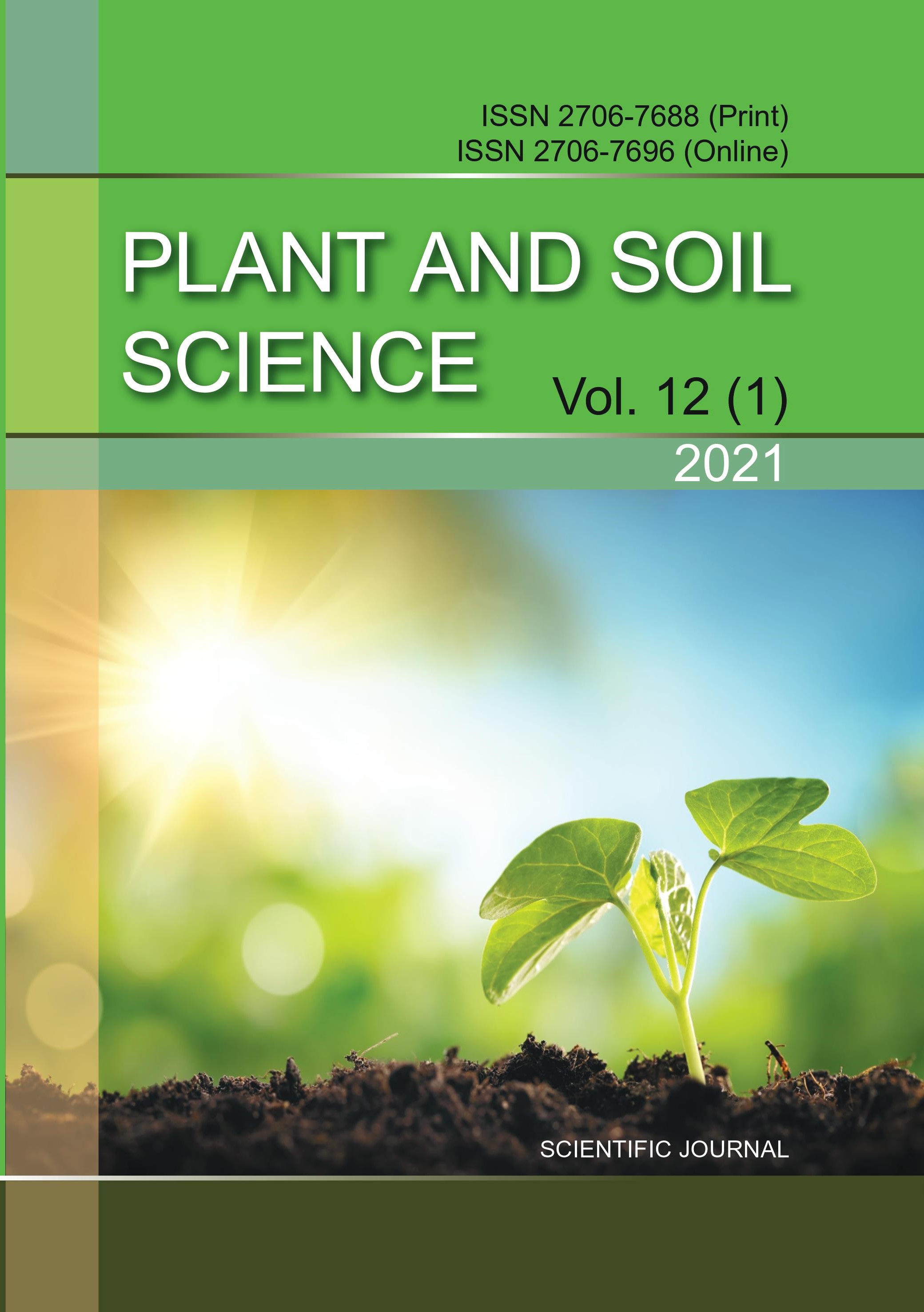Qualitative characteristics of Ribes Rubrum L. varieties breeding at the department of horticulture named after prof. V.L. Symyrenko NULES of Ukraine
DOI:
https://doi.org/10.31548/agr2021.01.120Keywords:
mass of berry, cluster, bush, biochemical composition, tasting estimation, quality of berries, tasteAbstract
The results of research on the quality of seven varieties of red currants (Ribes rubrum L.), five of which are created by the Department of Horticulture named after prof. V.L. Symyrenko NULES of Ukraine.References
Cristina, P., Alina, I., and Cristina, M. (2013). Production and quality potential of different black and red currant cultivars in Baneasa Research Station condition. Journal of Horticulture, Forestry and Biotechnology, 17 (4), 76-79.
Derzhanvyi reiestr sortiv roslyn Ukrainy prydatnykh dlia poshyrennia v Ukraini v 2020 [State Register of Plant Varieties Suitable for Dissemination in Ukraine in 2020]. (2020). Retrieved from https://sops.gov.ua/reestr-sortiv-roslin. (in Ukrainian)
Djordjevic, B. S., Djurovic, D. B., Zec, G. D., Meland, M. O., & Fotiric Aksic, M. M. (2020). Effects of shoot age on biological and chemical properties of red currant (Ribes rubrum L.) cultivars. Folia Horticulturae, 32 (2), 291-305.
https://doi.org/10.2478/fhort-2020-0026
Djordjević, B., Rakonjac, V., Fotirić Akšić, M., Šavikin, K., & Vulić, T. (2014). Pomological and biochemical characterization of European currant berry (Ribes sp.) Cultivars. Scientia Horticulturae, 165, 156-162.
https://doi.org/10.1016/j.scienta.2013.11.014
Golyayeva, O. D. (2010). Mezhvidovaya gibridizatsiya smorodiny krasnoy [Interspecific hybridization of red currant]. Materialy mezhdunarodnoy nauchno-prakticheskoy konferentsii, 62-64 (In Russ.).
Gündeşli, M. A., Korkmaz, N., Okatan, V. (2019). Polyphenol content and antioxidant capacity of berries: A review. Int. J. Agric. For. Life Sci., 3(2): 350-361. Retrieved from https://www.ijafls.org/en/pub/issue/47015/649812.
Heijerman, G. and van Gessel, G. (2020). Higher profits with planting hole treatment in red currant. Acta Hortic. 1277, 239-244.
https://doi.org/10.17660/ActaHortic.2020.1277.34
Karhu, S., Bles, C., Laine, K. and Palonen, P. (2020). Improving the performance of red and white currants in high latitude conditions by training methods. Acta Hortic. 1277, 225-232.
https://doi.org/10.17660/ActaHortic.2020.1277.32
Kopan', V. P. (2005) Metodi, rezul'tati і perspektivi selektsії plodovikh ta yagіdnikh kul'tur v Іnstitutі sadіvnitstva UAAN [Methods, results and prospects of selection of fruit and berry crops at the Institute of Horticulture NAAS]. Sadіvnitstvo: mіzhvіd. temat. zb. - Kyiv: Fіrma «SERZH». 2005, 57, 47-65. (In Ukrainian).
Makarkina, M. A. (2013). Selektsiya smorodiny krasnoy Ribes rubrum L. na uluchshennyy khimicheskiy sostav yagod [Breeding the red currant Ribes rubrum L. on improved chemical composition of berries]. Sel's'kokhozyaystvennaya biologiya, 3, 18. (in Russ.)
https://doi.org/10.15389/agrobiology.2013.3.18eng
Metodika provedennya ekspertizi sortіv porіchok bіlikh і chervonikh (Ribes niveum Lindl i R. sylvestre (Lam.) Mert. & W.D.J. Koch (sin. Ribes rubrum L.)) na vіdmіnnіst', odnorіdnіst' і stabіl'nіst' [Method of examination grades white and red currants (Ribes niveum Lindl i R. sylvestre (Lam.) Mert. & WDJ Koch (son. Ribes rubrum L.)) to the difference, homogeneity and stability]. (2012). ІES Ukrainy, 9. (in Ukrainian).
Mezhenskyj, V., Kondratenko, T., Mazur, B., Shevchuk, N., Andrusyk, Yu., Kuzminets O. (2020). Results of Ribes breeding at the National University of Life and Environmental Sciences of Ukraine. Research for Rural Development 2020: Proc. of 26th Ann. Inter. Sc. Conf. 15-17 May, 2020, 22-26.
https://doi.org/10.22616/rrd.26.2020.003
Mikulic-Petkovsek, M., Koron, D., & Veberic, R. (2016). Quality parameters of currant berries from three different cluster positions. Scientia Horticulturae, 210, 188-196.
https://doi.org/10.1016/j.scienta.2016.07.030
Milošević, T., Milošević, N. (2018). Vegetative Growth, Productivity, Berry Quality Attributes and Leaf Macronutrients Content of Currants as Affected by Species and Cultivars. Erwerbs-Obstbau 60, 53-65.
https://doi.org/10.1007/s10341-017-0339-5
Paprstein, F., Sedlak, J. and Kaplan, J. (2016). Rescue of red and white currant germplasm in the Czech Republic. Acta Hortic. 1133, 49-52.
https://doi.org/10.17660/ActaHortic.2016.1133.8
Salina, YE. S., Levgerova, N. S., Sidorova, I. A., Golyayeva, O. D. (2020). Khimiko-tekhnologicheskaya otsenka sortoobraztsov smorodiny krasnoy selektsii Vserossiyskogo nauchno-issledovatel'skogo instituta selektsii plodovykh kul'tur dlya zhele [Chemical and technological assessment of All-Russian Research Institute of Fruit Crop Breeding red currant cultivars for jellification]. Sadovodstvo i vinogradarstvo. 6, 46-55.
https://doi.org/10.31676/0235-2591-2020-6-46-55
Sedov, E. N., & Ogoltsova, T. P. (Eds.). (1999). Programma i metodika sortoizucheniya plodovykh, yagodnykh i orekhoplodnykh kultur [Programme and methods of varietal study of fruit, small fruit, and nut crops]. Orel: All-Russian Res. Inst. Breeding Fruit Crops, 351-374. (in Russ.).
Selma Berk, Muttalip Gundogdu, Selma Tuna & Akgul Tas (2020). Role of Maturity Stages on Phenolic Compounds and Organic Acids Contents in Red Currant Fruits. International Journal of Fruit Science, 20: sup 2, 1054-1071
https://doi.org/10.1080/15538362.2020.1774476
Sherenhovyi, P. Z. (2011). Moie zhyttia - v moikh sortakh (My life is in my varieties). Vinnytsia: FOP D. Yu. Korzun, 168. (In Ukrainian).
Tarapata, A. І. (2005) Osnovi іntensivnoї tekhnologії viroshchuvannya chornoї smorodini ta porіchok [Fundamentals of intensive technology of growing black currants and currants]. Sadіvnitstvo: mіzhvіd. temat. zb. K.: Fіrma «SERZH», 57, 300-304 (in Ukrainian).
Yareshchenko, A., Tereshchenko, Y., Pryimachuk, L., Todosyuk, E. and Mazur, B. (2012). Ribes breeding programmes in Ukraine - recent achievements. Acta Hortic. 946, 177-182. doi: 10.17660/ActaHortic.2012.946.27
https://doi.org/10.17660/ActaHortic.2012.946.27
Zdunić, G., Šavikin, K., Pljevljakušić, D., & Djordjević, B. (2016). Black (Ribes nigrum L.) and Red Currant (Ribes rubrum L.) Cultivars. Nutritional Composition of Fruit Cultivars, 101-126.
Downloads
Published
Issue
Section
License
Relationship between right holders and users shall be governed by the terms of the license Creative Commons Attribution – non-commercial – Distribution On Same Conditions 4.0 international (CC BY-NC-SA 4.0):https://creativecommons.org/licenses/by-nc-sa/4.0/deed.uk
Authors who publish with this journal agree to the following terms:
- Authors retain copyright and grant the journal right of first publication with the work simultaneously licensed under a Creative Commons Attribution License that allows others to share the work with an acknowledgement of the work's authorship and initial publication in this journal.
- Authors are able to enter into separate, additional contractual arrangements for the non-exclusive distribution of the journal's published version of the work (e.g., post it to an institutional repository or publish it in a book), with an acknowledgement of its initial publication in this journal.
- Authors are permitted and encouraged to post their work online (e.g., in institutional repositories or on their website) prior to and during the submission process, as it can lead to productive exchanges, as well as earlier and greater citation of published work (See The Effect of Open Access).

